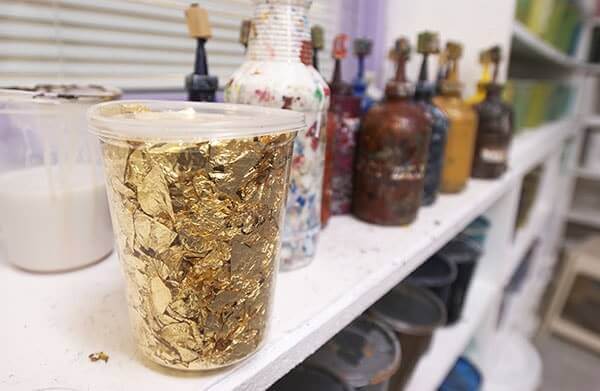SPECIAL EFFECTS & FINISHES
Because of our unique combination of equipment and skills, we have the ability to add special touches to a printed fine art edition. We call these techniques “special effects.” They are easily applied to silk screen fine art prints and varnished giclee prints, and the result is a mixed-media fine art print using old world printing techniques and the newest digital technology.
Gold & Silver Leaf (Gilding)
Gilding is a craft dating back hundreds of years, using gold leaf, an extremely thin foil made of gold. It is available in various colors, each with a different proportion of copper, silver or other metal in the alloy. To apply gold leaf to a fine art print, an ink drawing of the area to be gilded is made and burned into a screen. The leaf is attached to the print with an adhesive known as gold size. It is printed on to the prints and allowed to dry until it is no longer liquid and has a tacky surface. Next, the thin leaves of gold are applied by hand. This is done with a soft brush called a gilder’s tip. Once the gold has been applied, it is softly burnished and the excess gold is brushed away. Real gold leaf will not tarnish, so no varnish is necessary. Silver, imitation gold, and copper all will tarnish and should be printed with a protective gloss coating.
Metallic & Pearlescent Colors
Metallic inks, pearlescent and interference pigments add a subtle but dynamic richness to a fine art print. The areas printed with these inks will be a bit more glossy but will also have a metallic sheen when viewed from certain angles in the case of the metallic colors. The pearlescent or interference pigments will change color when viewed from different angles, much like looking at the iridescence of a butterfly’s wings.
Glitter
It is possible to apply a layer of glitter to a print. A drawing is made of the areas that the glitter is to be applied and the art is burned onto a special screen designed to allow the glitter to pass through the mesh and onto the print. There are a wide variety of glitters available for silkscreen printing therefore the color range is not limited.
The same technique is used to add textural elements to a print. Colored sand available at art supply stores, dry pigments and even reflective beads can be added to clear varnishes or colored inks, adding a unique surface to the print.
Texture
The silkscreen process tends to create a print with a distinct tactile surface because each color printed is a layer of ink rather than an imprint made by pressing the paper against an inked plate. By adding thickening agents to clear gloss coatings and printing with screens with a more open mesh this textural effect can be further emphasized.
This is done in much the same way that a color separation is done. A drawing in black ink is made of the texture that is desired. It can be an all over effect or limited to certain areas. It could have the look of brush strokes or could simply emphasize certain lines or design elements. Once the drawing is created it is put onto a screen and into the printing press. It can be printed once or for a more dramatic effect, printed two or three times to build up the surface. This can also be done with UV cure ink over a UV varnish.
Hand Brushed Acrylic
Sometimes, in order to add surface interest to a giclée print, a gloss varnish is brushed on by hand. The brush marks add a textural finish that compliments the crispness of the digital printing. This is done on both canvas and paper editions.
UV Gloss & Other High Gloss Coatings
All of our gloss varnishes [Gloss | Extra Gloss | UV Gloss] are available as well

Learn more about our other methodologies: